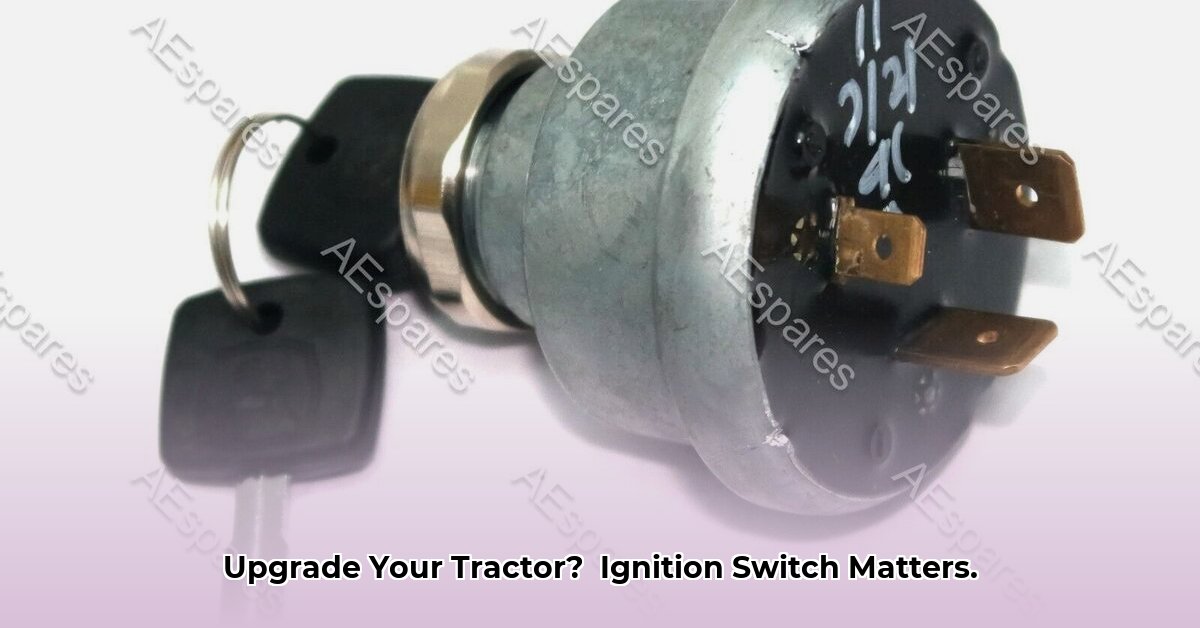
Imagine this: you're in the midst of harvest, and your tractor sputters to a halt. A faulty ignition switch can bring your entire operation to a standstill, costing you valuable time and money. This isn't just about inconvenience; a compromised ignition system also increases the risk of theft, resulting in even greater financial losses. Choosing the right ignition switch is a critical investment in the smooth, efficient, and secure operation of your farm. This comprehensive guide will help you select, install, maintain, and secure your tractor's ignition system, maximizing your farm's efficiency and promoting sustainable practices. For information on choosing a reliable tractor brand, check out this helpful resource on Massey Ferguson tractors.
Choosing the Right Tractor Ignition Switch: A Critical Decision
Selecting a tractor ignition switch isn't a simple matter of grabbing the cheapest option. It's an investment in the longevity and security of your operation. Consider these crucial factors:
Durability: Agricultural environments are harsh. Your switch needs to withstand dust, mud, rain, extreme temperatures, and constant vibration. A robust, long-lasting switch made from high-quality materials will minimize downtime and replacement costs. Look for switches with sealed housings to protect against water ingress.
Security: Tractor theft is a significant concern. A high-quality switch with integrated anti-theft features, such as locking mechanisms or tamper-resistant designs, acts as a significant deterrent. Consider switches with key-coded cylinders or electronic immobilizers for added security. How much would a stolen tractor cost your farm? This is a question every farmer must consider when prioritizing security.
Compatibility: Ensure the switch is compatible with your specific tractor model and year. Incorrect compatibility can lead to malfunctions and potentially damage other components. Consult your tractor's owner's manual or contact your local agricultural equipment dealer to verify compatibility. Do you know the exact specifications of your tractor's electrical system? This is crucial for choosing a compatible switch.
Amperage Rating: The switch must safely handle the total amperage draw of your tractor's electrical system. An insufficient amperage rating will quickly lead to overheating and failure. Always choose a switch with a higher amperage rating than your system requires.
Installing and Maintaining Your Tractor Ignition Switch: A Practical Guide
Replacing a tractor ignition switch may seem daunting, but with careful attention to detail and these steps (with professional installation recommended for complex systems), you can often accomplish it yourself:
Safety First: Always disconnect the negative battery terminal before commencing any work. This crucial step prevents electrical shocks and short circuits.
Removing the Old Switch: Carefully remove the old ignition switch. Take photographs or detailed notes of the wiring configuration to assist with reinstalling the new switch.
Installing the New Switch: Gently install the new switch, ensuring proper alignment. Carefully reconnect the wiring, precisely matching the original configuration. Refer to your switch's wiring diagram.
Reconnection and Testing: Reconnect the negative battery terminal. Turn the key. If correctly installed, your tractor should start without issue.
Routine Maintenance: Regularly inspect for loose wires, corrosion, or damage. Clean terminals with a wire brush and apply a dielectric grease to prevent corrosion. How often do you inspect your tractor's electrical system? Regular maintenance prevents costly repairs later on.
Troubleshooting Common Tractor Ignition Switch Issues: Quick Diagnostics
Even high-quality switches can experience problems. Address these common issues promptly:
No Power: Check the battery connection, fuses, and wiring for breaks or loose connections before assuming the switch itself is faulty.
Intermittent Starting: This often points to a faulty switch. Inspect for loose connections or internal damage. Consider applying a small amount of electrical contact cleaner to the terminals. If the problem persists, replacement is usually necessary.
Difficult Turning: Lubricate the switch mechanism with a suitable lubricant (refer to the manufacturer's specifications). Stiffness frequently arises from corrosion—clean the terminals thoroughly before lubricating.
Enhancing Security: Protecting Your Investment
Tractor theft is a significant concern. Choose a secure switch and consider these supplementary measures:
GPS Tracking: Real-time tracking allows for quick location and recovery of a stolen tractor.
Alarm Systems: A loud alarm discourages theft and alerts you to unauthorized access.
Secure Storage: Store your tractor in a locked building or utilize heavy-duty, locked storage covers. These measures create a layered approach to security.
Sustainability Considerations: Farming Responsibly
Selecting a durable, long-lasting switch is a cornerstone of sustainable agriculture. It reduces waste from frequent replacements and minimizes your environmental impact. If possible, prioritize switches manufactured using recycled materials. This small choice contributes to a greener agricultural sector. Dr. Emily Carter, Professor of Chemical and Biological Engineering at Princeton University, emphasizes that "Sustainable agriculture requires a holistic approach; seemingly minor choices, like selecting durable equipment, cumulatively contribute to significant environmental benefits."
Recommendations for Different Stakeholders
| Stakeholder | Key Considerations |
|---|---|
| Farmers/Ranchers | Durability, security, compatibility, and regular maintenance. |
| Equipment Manufacturers | Robust designs, sustainable materials, integrated security features. |
| Agricultural Retailers | Providing a range of high-quality switches with clear information on their features and benefits. |
In conclusion, the choice of tractor ignition switch is a critical decision affecting farm efficiency, security, and sustainability. By carefully considering the factors outlined in this guide, farmers can minimize downtime, prevent theft, and contribute to a more environmentally responsible agricultural practice.